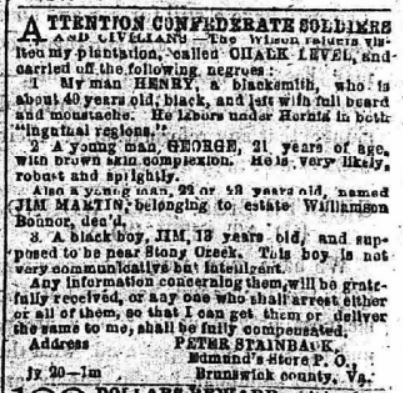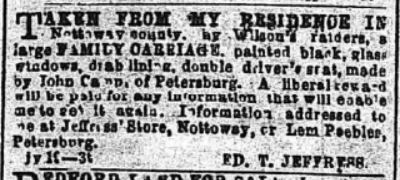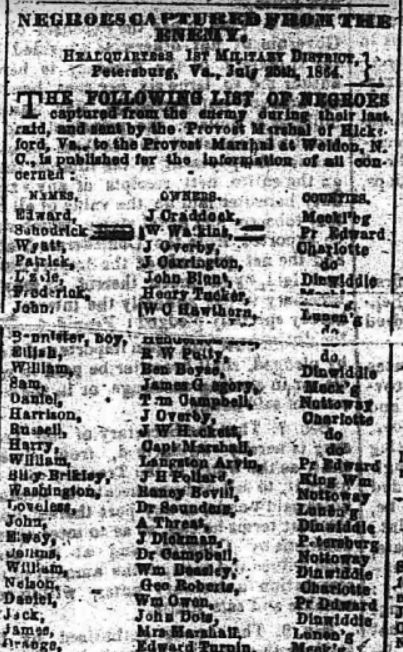The Effects of the Wilson-Kautz Raid through Newspaper Advertisements (part two of two)
 ECW is pleased to welcome back Tim Talbott (part two of two)
ECW is pleased to welcome back Tim Talbott (part two of two)
Evidence of the amount of disorder the Union horsemen wreaked on the region’s citizens during the Wilson-Kautz Raid appears in numerous newspaper advertisements placed by individuals seeking to reclaim their property. As mentioned in the first part of this series, much of that property came in human form.
An accounting of some of the enslaved people comes from an advertisement published in the Petersburg Daily Express newspaper in July by James H. Pearce, who served as assistant adjutant general for Brig. Gen. Henry Wise. The printed enumeration gives the names, owners, and counties of origin of 48 people recaptured by the Confederates. On July 11, 1864, M. M. Rodgers, provost marshal for Wickham’s Cavalry Brigade, advertised in the Express the arrest on July 3, near Reams’ Station, of an enslaved man named Owens, who Rodgers “supposed to have been with Wilson’s raiders and been separated from them in this neighborhood.”
In the hectic scramble to get back to Union lines, while along the Stage Road near Reams’ Station, some children, who briefly got a taste of freedom while with the raiders, found themselves left behind and recaptured. James Hargrave advertised in the July 18 issue of the Petersburg Express that he “picked up . . . three negro children.” Willie, Minnie, and “a little boy, name unknown” who were ages 5, 4, and 3 respectively. Dr. D. J. Claiborne, Sr. of Brunswick County sought to reclaim three of his enslaved people, as he believed, “taken from me by the last Yankee raid. . . .” Claiborne offered a liberal compensation for 19-year-old Lucy, 15-year-old Irmma, and nine-year-old Charles, all siblings.
From the same Brunswick County neighborhood as Dr. Claiborne, Peter Stainback advertised on July 22 that “The Wilson raiders visited my plantation . . . and carried off the following negroes:” Henry, George, Jim Martin, and another Jim.
Children seemed to have the hardest time escaping recapture. John Dodson advertised on July 28 in the Express that he had on his place a girl named Amy who was about six years old. Dodson also provided the names of the girl’s mother and father, but Amy was “unable to give any other account of herself or owner.” Abram W. Marshall of Lunenburg County wanted “Harod, but was generally known by the name Peter . . . Armistead . . . and Kenner,” “who were taken . . . by the Wilson’s raiders.” Dr. Thomas Blandry offered a $200 reward for Sarah Ann and her two children Minna and Garland who fled with the raiders at Blacks and Whites Station on the Southside Railroad.
The day after the raid ended, Maj. W. H. Kerr at Petersburg posted a notice in the Express warning “not to purchase or trade in any way for property captured from the enemy.” Kerr listed commonly confiscated items including: “horses, mules, carts, wagons, buggies &c. . . .” Nelson Griffin of Dinwiddie County advertised that “a body of retreating Yankee soldiers,” took away two mules, a mare and a horse. Griffin also claimed that the raiders or “vandals” as he referred to them, took “every pound of bacon, all the corn, butter, and everything else of value. . . .”
R. R. Collier took out a classified ad that claimed that Wilson’s men “robbed my negro man, Bob, a faithful slave, of two and a half dollars in silver.” Collier offered a $20 reward for anyone who would deliver the thief to him in Petersburg. For items “Stolen by Wilson’s Yankee Raiders,” T. A. Proctor offered a $1000 reward. He explained in the July 11 issue of the Express that the raiders took silverware including spoons, knives, and forks. Also missing were “one Pitcher and Waiter, two Goblets, Cake Knife, Pickle Knife and Forks, two Salt stands, on Butter Stand,” among other items that were “prized beyond their pecuniary value . . . .”
Lunenburg County resident Sterling Neblett lost horses and mules that he sought back by advertising the July 13 Express. John Puryear of Brunswick also wanted his six horses back from “The Wilson Raiders who visited my plantation and stole” them. Ed. T. Jeffress of Nottoway County wanted his “large family carriage” that was “taken from my residence . . . by Wilson’s raiders.” Jefferess offered a “liberal reward” in his ad placed in the July 19 Express.
Robert Jackson lost five horses and mules and advertised for their return in the August 8 issue of the Express.
In the grand scheme of the Petersburg Campaign, the tangible military advantages gained by Federal forces through the Wilson-Kautz Raid were probably quite minimal. A good number of the enslaved people who followed the raiders seeking freedom, and materials and animals confiscated along its course, fell back into Confederate hands at the end of the raid. But, some in Federal high command believed the effort was well worth its costs in casualties. Certainly, the raiders created enough damage to Confederate rail and communications infrastructure that it took time, as well as valuable manpower and resources away from the Confederates—who had little to spare—to repair them.
However, the raid’s greatest effect was likely the many disturbances it had on white Southern civilians, and as expressed in their advertisements attempting to reclaim their possessions. The raiders’ ability to range as far as they did and seemingly take what they wanted all while helping enforce the Emancipation Proclamation, continued to erode the confidence that white Southern civilians placed in their military and government officials to protect them. While raids like that conducted by Wilson’s and Kautz’s cavalrymen across Southside Virginia certainly embittered some Southerners, in others it started to dent their resolve and caused them to wonder when they again might experience “the hard hand of war.”
————-
Sources:
A. Wilson Greene, A Campaign of Giants: The Battles for Petersburg, Volume 1: From the Crossing of the James to the Crater, University of North Carolina Press, 2018.
Greg Eanes, ‘Destroy the Junction’: The Wilson-Kautz Raid & the Battle for the Staunton River Bridge, June 21 to July 1, 1864, H. E. Howard and Company, 1999.
Map of Virginia: Showing the distribution of its slave population from the Census of 1860 accessed via Library of Congress
Richmond, Virginia Daily Dispatch
- August 6, 1864
- August 26, 1864
Petersburg, Virginia Daily Express
- July 1, 1864
- July 7, 1864
- July 11, 1864
- July 13, 1864
- July 18, 1864
- July 19, 1864
- July 22, 1864
- July 28, 1864
- August 5, 1864
- August 6, 1864
————
Tim Talbott is the Director of Education, Interpretation, Visitor Services, and Collections at Pamplin Historical Park and the National Museum of the Civil War Soldier in Petersburg, Virginia. He is also the founding member and President of the Battle of New Market Heights Memorial and Education Association. Tim maintains the “Random Thoughts on History” blog and has published articles in both book and scholarly journal format. His current project is researching soldiers captured during the Petersburg Campaign.




Thanks, this post provides new information and analysis.
Great articles. Thanks!
It is nice to see some new information on this event. I have been studying it for many years.